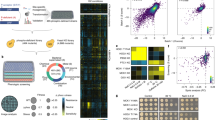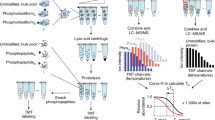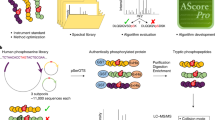Abstract
Protein kinases are coded by more than 2,000 genes and thus constitute the largest single enzyme family in the human genome. Most cellular processes are in fact regulated by the reversible phosphorylation of proteins on serine, threonine, and tyrosine residues1. At least 30% of all proteins are thought to contain covalently bound phosphate. Despite the importance and widespread occurrence of this modification, identification of sites of protein phosphorylation is still a challenge, even when performed on highly purified protein2. Reported here is methodology that should make it possible to characterize most, if not all, phosphoproteins from a whole-cell lysate in a single experiment. Proteins are digested with trypsin and the resulting peptides are then converted to methyl esters, enriched for phosphopeptides by immobilized metal-affinity chromatography (IMAC)3,4, and analyzed by nanoflow HPLC/electrospray ionization mass spectrometry. More than 1,000 phosphopeptides were detected when the methodology was applied to the analysis of a whole-cell lysate from Saccharomyces cerevisiae. A total of 216 peptide sequences defining 383 sites of phosphorylation were determined. Of these, 60 were singly phosphorylated, 145 doubly phosphorylated, and 11 triply phosphorylated. Comparison with the literature revealed that 18 of these sites were previously identified, including the doubly phosphorylated motif pTXpY derived from the activation loop of two mitogen-activated protein (MAP) kinases. We note that the methodology can easily be extended to display and quantify differential expression of phosphoproteins in two different cell systems, and therefore demonstrates an approach for “phosphoprofiling” as a measure of cellular states.
This is a preview of subscription content, access via your institution
Access options
Subscribe to this journal
Receive 12 print issues and online access
$209.00 per year
only $17.42 per issue
Buy this article
- Purchase on Springer Link
- Instant access to full article PDF
Prices may be subject to local taxes which are calculated during checkout

Similar content being viewed by others
References
Hubbard, M.J. & Cohen, P. On target with a new mechanism for the regulation of protein phosphorylation. Trends Biochem. Sci. 18, 172–177 (1993).
Annan, R., Huddleston, M., Verma, R., Deshaies, R. & Carr, S. A multidimensional electrospray MS-based approach to phosphopeptide mapping. Anal. Chem. 73, 393–404 (2001).
Andersson, L. & Porath, J. Isolation of phosphoproteins by immobilized metal (Fe3+) affinity chromatography. Anal. Biochem. 154, 250–254 (1986).
Michel, H., Hunt, D.F., Shabanowitz, J. & Bennett, J. Tandem mass spectrometry reveals that three photosystem II proteins of spinach chloroplasts contain N-acetyl-O-phosphothreonine at their NH2 termini. J. Biol. Chem. 263, 1123–1130 (1988).
Eng, J., McCormack, A.L. & Yates, J.R. An approach to correlate tandem mass spectral data of peptides with amino acid sequences in a protein database. J. Am. Soc. Mass Spectrom. 5, 976–989 (1994).
Bennetzen, J.L. & Hall, B.D. Codon selection in yeast. J. Biol. Chem. 257, 3026–3031 (1982).
Oda, Y., Nagasu, T. & Chait, B. Enrichment analysis of phosphorylated proteins as a tool for probing the phosphoproteome. Nat. Biotechnol. 19, 379–382 (2001).
Zhou, H., Watts, J. & Aebersold, R. A systematic approach to the analysis of protein phosphorylation. Nat. Biotechnol. 19, 375–378 (2001).
Martin, S.E., Shabanowitz, J., Hunt, D.F. & Marto, J.A. Subfemtomole MS and MS/MS peptide sequence analysis using nano-HPLC micro-ESI Fourier transform ion cyclotron resonance mass spectrometry. Anal. Chem. 72, 4266–4274 (2000).
Zarling, A.L. et al. Phosphorylated peptides are naturally processed and presented by major histocompatibility complex class I molecules in vivo. J. Exp. Med. 192, 1755–1762 (2000).
Acknowledgements
This work was supported by US Public Health Service Grant, GM 37537 to D.F.H.
Author information
Authors and Affiliations
Corresponding author
Ethics declarations
Competing interests
F.M.W. and M.M.R. are employed by MDS Proteomics. J.S. and D.F.H. are consultants to MDS Proteomics.
Rights and permissions
About this article
Cite this article
Ficarro, S., McCleland, M., Stukenberg, P. et al. Phosphoproteome analysis by mass spectrometry and its application to Saccharomyces cerevisiae. Nat Biotechnol 20, 301–305 (2002). https://doi.org/10.1038/nbt0302-301
Received:
Accepted:
Issue Date:
DOI: https://doi.org/10.1038/nbt0302-301
This article is cited by
-
Adnp-mutant mice with cognitive inflexibility, CaMKIIα hyperactivity, and synaptic plasticity deficits
Molecular Psychiatry (2023)
-
Inferring differential subcellular localisation in comparative spatial proteomics using BANDLE
Nature Communications (2022)
-
Phosphorylation activates the yeast small heat shock protein Hsp26 by weakening domain contacts in the oligomer ensemble
Nature Communications (2021)



